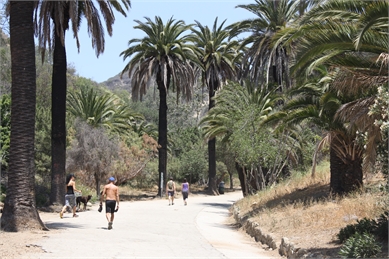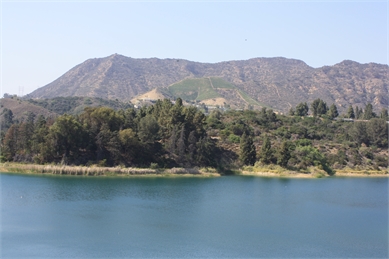No video provided.
Hiking Hollywood
Hollywood is often seen as the grittiest, most urban part of Los Angeles. Yet Hollywood contains some of LA’s greenest pastures, for hiking, dog walking, photography, or simply enjoying green space and spectacular vistas.
For many people, Hollywood hiking doesn’t extend beyond strolling down Hollywood Boulevard, visiting the famous stars on the Walk of Fame, or watching wanna-bees in costume impersonate real and imaginary characters like Superman and Michael Jackson.
But leaving the flats and climbing the hills of Hollywood will bring an unexpected reward. Just above the city, where the Hollywood Hills meet the Santa Monica Mountains, a network of trails and parks puts the city below (and the Hollywood sign above) in perspective. Places like Runyon Canyon, Lake Hollywood and Griffith Park not only provide a respite from the urban jungle, but have themselves been featured in famous Hollywood productions.
Runyon Canyon Park

Runyon Canyon is the domain of the young, the beautiful, the athletic and their dogs. Shorts and spandex are the uniform de rigueur.
Runyon Canyon is perhaps the most accessible Hollywood hiking trail. This 130 acre park is truly in Hollywood, just two blocks from Hollywood Boulevard. There are entrances to the park on Fuller Avenue and on Vista Street in Hollywood, and off Mulholland Drive in the north. The easiest to find is the entrance at the top of Fuller, a couple of blocks north of Hollywood Boulevard and west of La Brea Avenue. If you arrive by car, be warned: street parking can be scarce in the densely-packed residential area, so park at the Mulholland trailhead.
The area around the park, especially just to the west, has many beautiful Hollywood homes, like the house on Camino Palmero where The Adventures of Ozzie and Harriet was set and where future pop star Ricky Nelson grew up.
Once you’re on Fuller heading north into the hills, it will be difficult to miss the park, as a stream of attractive people in workout gear and their dog will be striding in and out of the gate. Entering Runyon Canyon from Fuller, you’ll see a flat, grassy area surrounded by a fence the only dog-free area in the park. It’s an area where free yoga classes are usually given every morning.
There are three major hiking trails, which do require a bit of exertion as they gain elevation in the Hollywood Hills. The main trail continues past the grassy “yoga zone”, past a stand of cactus and the mysterious ruins of the foundation of a house, up and to the right (east) along the hillside.
The trails offer marvelous vistas overlooking the city, including luxurious homes and pools as well as the Hollywood sign and the Griffith Observatory to the east. Continuing perhaps a mile and a half to the “Big Chair” (actually an elevated bench that looks out over Hollywood) provides a wonderful view of Hollywood landmarks like the Capitol Records building and the Cinerama Dome.
In the far distance are the skyscrapers of downtown LA, seven miles to the south east. The towers of Century City to the west and the jets rising out of LAX can often be spotted, and on a clear day, you can see the Pacific Ocean, 12 miles to the west.
Because of the area’s history of private home ownership until its 1983 donation to the city, fewer shows have been filmed in Runyon Canyon although Scream 3 was filmed in a home off one of the trails, and a 1992 episode of Seinfeld (“The Trip, Part 2”) was filmed near the big chair. More recently, the cast and crew of the wacky IFC TV show Portlandia “took over” the park, renaming it “Beaver Canyon.”
Lake Hollywood

With the pine trees surrounding the “lake” (actually a former reservoir) Lake Hollywood is like a quick trip to the Pacific Northwest, without the rain. In addition to the fragrant pine, oak, eucalyptus, agave, and sage can be seen (and smelled) and birds, rabbits and lizards are often in evidence. The reservoir, built in 1924, was created by the building of the Mulholland Dam, part of the elaborate process of bringing water from Northern California to the Los Angeles area. (A fictionalized version of the process can be seen in the Oscar-winning Chinatown, starring Jack Nicholson).
In addition to Chinatown, the 1974 movie Earthquake was partially filmed at the Dam. Aftershocks of the “earthquake” in the title collapse the dam and create a catastrophic flood. The fictional disaster may be echoed in today’s security concerns, as signs around the dam forbid filming.
The lake, or reservoir, is not open to public access, although that doesn’t seem to stop the ducks and other birds occasionally spotted there. Most of the lake and surrounding forests glimpsed through a chain-link fence, but the 1000-foot long Mulholland Dam provides unobstructed views of the lake, the trees and the Hollywood Hills beyond. (There are many outstanding vistas nearby for close-up viewing and photography of the Hollywood Sign.
There are a number of ways to reach the lake, with one of the easiest being exiting the 101 freeway at Barham Blvd. and taking Barham to Lake Hollywood Drive, where there’s plenty of available roadside parking. Parking by the dam can be difficult to find, and the drive up the hill can be a bit harrowing as well. To drive directly to the dam requires driving a very narrow residential street that’s unmarked.
The good news is that the drive up has taken the entire hill out of the climb. What’s left is a scenic 3.5 mile loop around the lake with only a 100 foot elevation gain. It’s perfect for a leisurely (or brisk) walk or jog. The flat ground, without cars, also makes the path an ideal place to teach children how to ride a bicycle; the author taught both his kids there. Just don’t bring your dogs; unlike the other two hikes on this list, dogs are forbidden from the lake.
Bronson Canyon/Griffith Park Caves
Many Angelenos have never seen the caves of Griffith Park in person. Yet millions of people around the world have seen the caves, which, like many other parts of Griffith Park, are featured in film and television shows like Batman,(as, yes, the Bat Cave), Rebel Without A Cause (shot at the Griffith Park Observatory) NCIS, 24,Gilmore Girls, Desperate Housewives, and countless others.
With 4,100 acres of parkland and 53 miles of trails, Griffith Park is the largest municipal park and urban wilderness area in the United States. The park has been used as a film and television location since the early days of motion pictures. As pioneering Hollywood producer Samuel Goldwyn, best known as a founder of both Paramount and MGM, put it “A tree is a tree, a rock is a rock, shoot it in Griffith Park.”
Mt. Hollywood Drive even doubled as Vermont in a snowy scene from the 1987 feature Baby Boom. The set designer and crew used soap suds and crushed ice to simulate a New England winter landscape.
The Bronson Canyon caves, originally built as a granite quarry in 1903, have particularly been used in the filming of science fiction, fantasy/horror and Western films. These include Lost Horizon, Star Trek VI: The Undiscovered Country, Army of Darkness, George of the Jungle, The Scorpion King, the original Invasion of the Body Snatchers (1956) and the infamously awful Robot Monster (1953). Dozens of TV shows have also been filmed there, from Batman, Bonanza and Gunsmoke to all five Star Trek television series.
To get find the caves, drive or walk in the southwestern entrance to Griffith Park, going from Franklin Avenue north on Canyon Drive. Past the park entrance, it’s about a quarter mile to the red bridge, (really just a pair of long concrete ledges on your right. As you walk up the hill and down the trail, in about another fifteen minutes and a quarter to half a mile you’ll spot a big cave mouth.
It was a hot spring day when we visited, but the inside of the cave (really a limestone quarry bored out of the hillside) was cool. As I touched the walls I thought of all the science-fiction shows shot there, with the granite walls doubling for otherworldly places.
There are three exit mouths on the other side of the cave, perhaps 150 yards from the main entrance. When you exit the cave through one of the three exits mouths, walk a couple of hundred yards to the left. You’ll be rewarded by a fantastic view of the Hollywood Sign. It’s an easy hike, but if there are would be mountain goats in your party there are more challenging hillside trails for even better vistas.
If the hiking makes you hungry, lunch or a late breakfast at the Beachwood Café is a nice possibility; it’s just a few blocks away from the Bronson Caves.
These three great (and not particularly difficult) Hollywood hikes, in addition to offering exercise, clean air and a new view of Hollywood, are also free of charge. And, like experienced hikers, be sure to leave only footprints and take only pictures.